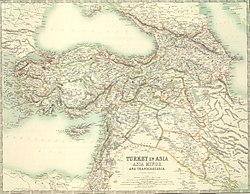Chobanids (beylik)
Chobanids / Çobanoğulları | |||||||||
|---|---|---|---|---|---|---|---|---|---|
| 1227–1309 | |||||||||
| Capital | Kastamonu | ||||||||
| Common languages | Turkish | ||||||||
| Religion | Sunni Islam | ||||||||
| Government | Emirate | ||||||||
| Bey | |||||||||
• 1227 | Hüsameddin Çoban Bey | ||||||||
• 1309 | Çobanoğlu Mahmud Bey | ||||||||
| Historical era | Late Medieval | ||||||||
• Established | 1227 | ||||||||
• Disestablished | 1309 | ||||||||
| |||||||||
| History of Turkey |
|---|
 |
| Timeline |
|
|
Chobanids (Turkish: Çobanoğulları or Çobanoğulları Beyliği) was an Anatolian beylik founded by the dynasty of the same name and controlled the region in and around the northern Central Anatolian city of Kastamonu in the 13th century, ruling as an independent entity in intervals.
History
The founder of the dynasty was Hüsamettin Çoban, a prominent statesman and a commander of the Sultans of Rum during the reigns of Kaykaus I and his successor Kayqubad I. In the early decades of the 13th century, Hüsamettin Çoban was one of the commanders of the raids that extended Seljuq territory in northern Anatolia at the expense of the Byzantine Empire of Trebizond. As a result, he had acquired Kastamonu as a fiefdom. Between 1224-1227, he also led the Seljuq army and fleet that set sail from Sinop and captured and fortified the city of Sudak in Crimea.[1]
After Hüsamettin Çoban's death, his hereditary possessions centered in Kastamonu were ruled respectively by his son and grandson, Alp Yürek and Yavlak Arslan. Until the last years of Yavlak Arslan's reign, the Chobanid Beys pursued a prudent policy of allegiance to the Mongols who had established their hegemony over Anatolia following the Battle of Köse Dag.[2] A rebellion in the end by Yavlak Arslan resulted in his death in battle before Kastamonu against combined Seljuq-Mongol forces, and the region was given to the Seljuq commander Shams al-Din Yaman Jandar, whose descendants were to found the Jandarids Principality in the same region.
Yaman Candar was momentarily pushed out of the region by Yavlak Arslan's son Çobanoğlu Mahmud Bey, who also organized further raids into Byzantine territory to extend his domain. But in 1309, this last Bey of Chobanids fell victim to an ambush by Yaman Candar's son Candaroğlu Süleyman Pasha and the region of Kastamonu passed to the Jandarids.
Chobanid dynasty left important works of architecture in and around Kastamonu. The Ottomans were vassals between 1281-1299 but declared independence after Yavlak Arslan stopped raiding the Byzantines in 1299.[citation needed]
List of rulers
- Hüsameddin Çoban (1227-?)
- Alp Yürek (?-1280)
- Muzafferüddin Yavlak Arslan (1280-1292)
- Çobanoğlu Mahmud Bey (1292-1309)
See also
References
- ^ A. C. S. Peacock, "The Saliūq Campaign against the Crimea and the Expansionist Policy of the Early Reign of'Alā' al-Dīn Kayqubād", Journal of the Royal Asiatic Society, Third Series, 16 (2006), p. 140
- ^ Stanford Shaw, History of the Ottoman Empire and Modern Turkey (Cambridge: University Press, 1976), vol. 1 p. 12
External links
- "Çobanoğlu" (in Turkish). Dallog.
{{cite web}}: External link in|publisher= - Kemâl Kutgün Eyüpgiller. "Fiziksel gelişimi, anıtsal yapıları ve konutları" (PDF). Kastamonu Kent Tarihi (Kastamonu City History) (in Turkish). Utrecht University.
{{cite web}}: Italic or bold markup not allowed in:|work=(help)
